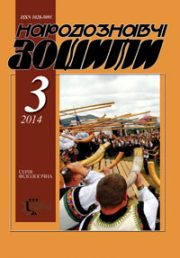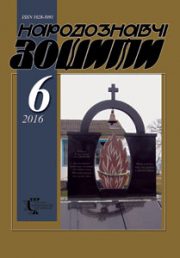The Ethnology Notebooks. 2017, 1 (133), 129–135
UDK 39:634(477.86)
DOI https://doi.org/10.15407/nz2017.01.129
ORCID ID: https://orcid.org/0000-0001-7241-9466
Received 16.01.2017
TRADITIONAL GARDENING AND WINEGROWING AT POKUTTIA
Taras Yaroslav Mykolaiovych, Head of Department, Professor, Doctor of Science, Doctor of Architecture, laureate of the State Prize of Ukraine in the field of architecture.
Svobody Avenue 15, 79000, Lviv, Ukraine.
Contacts: e-mail: etnomod@yandex.ua
Abstract. The traditional gardening and winegrowing of Pokuttia from ancient times until nowadays are highlighted; factors, which had influence on its spreading are presented; separate gardens about manners, castles, priest residences, are characterized; local denominations of trees are determined; traditional beliefs and customs, which were used for trees protection and ways of fruits preservation are under consideration.
Keywords: Pokuttia, Horodenkivshchyna, Kolomyishchyna, Tovmachchyna, Sniatynshchyna, agriculture, gardening, winegrowin
REFERENCES
Bazhanskyi, M. (1982). Krasa Sniatynshchyny: riky, potoky, lisy, luhy, sady, mista i sela ta vysoka materialna i dukhovna kultura yikhnikh zhyteliv: Haslova entsyklopediia. Ditroit [in Ukrainian].
Bazhanskyi, M. (1983). Tvorchyi dynamizm patriotyzmu moikh zemliakiv. Vid pershykh proiaviv orhanizovanykh suspilnykh hurtkiv, tserkovnykh bratstv, remisnychykh tsekhiv — azh do «Sichei», «Sokoliv», «Prosvit», «Ridnykh shkil» ta boiovykh formatsii i politychnykh partii: Haslova entsyklopediia. Ditroit [in Ukrainian].
Bakai, S. (1988). Moie ridne selo Kniazhdvir. In Kolomyia y Kolomyishchyna (pp. 645—660). Filadelfiia [in Ukrainian].
Vasylchuk, M. (2013). Trokhy pro Velykyi Kliuchiv. Yamhoriv (22—23, pp. 184—190). [in Ukrainian].
Vasnyi, V. (1988). Selo Zhukotyn. In Kolomyia y Kolomyishchyna. Zbirnyk spomyniv i statei pro nedavnie mynule. Faladelfiia [in Ukrainian].
Vyzdryk, V. (2015). Halytske selo: sotsialno-ekonomichne zhyt-tia ta suspilno-politychni protsesy (1919—1939). Lviv: Instytut ukrainoznavstva im. I. Krypiakevycha NAN Ukrainy [in Ukrainian].
Vovk, T. (2013). Tsiliushchi sady «Pokuttia-frukt». Sniatyn. 7, 9—15 [in Ukrainian].
Hoshynskyi, A. (2015). Povynnosti meshkantsiv Chernelytsi v druhii polovyni XVIII
stolittia. Yamhoriv (26) [in Ukrainian].
Hrabovetskyi, V. (2011). Ivanivtsi. Litopys sela nad Prutom. Ivano-Frankivsk : Nova Zoria [in Ukrainian].
Zubal, Ya. (1975). Sadzhavka. In Almanakh Stanyslavivskoi zemli: Zbirnyk materialiv do istorii Stanyslavova i Stanyslavivshchyny. Niu-York ; Toronto ; Miunkhen [in Ukrainian].
Kirieieva, R. (2014). Etnohrafiia Sniatyshchyny. Doslidnyky narodnoho pobutu i kultury. Sniatyn. 10, 27—33 [in Ukrainian].
Kolodnytskyi, O. (1975). Narodnyi pobut, zvychai i folklor Tovmachchyny. In Almanakh Stanyslavivskoi zemli: Zbirnyk materialiv do istorii Stanyslavova i Stanyslavivshchyny (pp. 876–888). Niu-York ; Toronto ; Miunkhen [in Ukrainian].
Romanenchuk, B. (Ed.). (1988). Kolomyia y Kolomyishchyna: Zbirnyk spomyniv i statei
pro nedavnie mynule. Istoryko-kraieznavche vydannia. Filadelfiia: Vydannia Komitetu Kolomyian [in Ukrainian].
Komarynska, D. (1978). Strilche. In Horodenshchyna. Istorychno-memuarnyi zbirnyk. Niu-
York ; Toronto ; Vinnipeh [in Ukrainian].
Kupchynskyi, B. (1994). Istoriia Tyshkivtsiv. Kolomyia: Vik [in Ukrainian].
Levkun, Ya. (2003). Selo lelek ta zolotavykh pshenyts. Sniatyn: Prut Prynt [in Ukrainian].
Levkun, Ya. (2007). Slavne pokutske selo Chortovets. In Levkun, Ya. Materialy do istorii sela. Sniatyn: Prut Prynt [in Ukrainian].
Makohon, I. (1978). Hlushkiv. In Horodenshchyna. Istorychno-memuarnyi zbirnyk (pp. 478—483). Niu-York; Toronto; Vinnipeh [in Ukrainian].
Mamchak, M. (2011). Kniazhe ponad Cheremoshem. Istorychnyi narys. Sniatyn: Prut Prynt [in Ukrainian].
Marunchak, M. Vidpustove selo Dalesheva. In Horodenshchyna. Istorychno-memuarnyi zbirnyk (pp. 538—544). Niu-York; Toronto; Vinnipeh [in Ukrainian].
Marchuk, V. (2010). Torhovytsia. Storinky istorii. Ivano-Frankivsk: LIK [in Ukrainian].
Monolatii, I. (2010). Tsisarska Kolomyia 1772—1918. Ivano-Frankivsk: Lileia-NV [in Ukrainian].
Mokhoruk, D. (2004). Selo moie Toporivtsi. Sniatyn: Prut Prynt [in Ukrainian].
Mokhoruk, D. (2008). Moi spivochi Toporivtsi. In Selo moie Toporivtsi (Vol. 5. ). Kosiv: Pysanyi Kamin [in Ukrainian].
Mokhoruk, D. (2008). Etnohrafichnyi obraz sela. In Selo moie Toporivtsi (Vol. 6). Kosiv: Pysanyi kamin [in Ukrainian].
Mrochko, Fr. K. (1977). Sniatynshchyna. Prychynky do kraiovoi etnohrafii (Vol. 1). Ditroit [in Ukrainian].
Nykyforuk, V. (1995). Starozhytnosti Horodenkivshchyny (u faktakh, lehendakh, domyslakh). Sniatyn: Nad Prutom [in Ukrainian].
Petryk, P. (1975). Mylovanie i yoho shkola Almanakh Stanyslavivskoi zemli: Zbirnyk materialiv do istorii Stanyslavova i Stanysla viv shchyny (pp. 491—497). Niu-York; Toronto; Miunkhen [in Ukrainian].
Romaniuk, Ya. (2012). Zaluchchia nad Cheremoshem. Sniatyn: Prut Prynt [in Ukrainian].
Siredzhuk, P. (2014). Novovyiavleni dokumenty z istorii zamkiv Sniatynshchyny. Sniatyn (8, pp. 47—520) [in Ukrainian].
Smerechanskyi, R., Kahlian, O. & Myroniuk, I.(2014). Vikiv mynulykh tverd. Horodenkivshchy na v starykh dokumentakh i svitlynakh. Ivano-Frankivsk : Lileia-NV [in Ukrainian].
Taras, V. (2006). Monastyrski sady Halychyny (X — seredyna XIX st.). Lviv: IN NANU [in Ukrainian].
Tymchuk, M. (1975). Hrushka. In Almanakh Stanyslavivskoi zemli: Zbirnyk materialiv do istorii Stanyslavova i Stanyslavivshchyny (pp. 899—908). Niu-York ; Toronto; Miunkhen [in Ukrainian].
Kharyton, V. (2012). Naseleni punkty Sniatynshchyny. Sniatyn: Prut Prynt [in Ukrainian].
Kharyton, V. (2010). Pokutiany. Literaturno-dokumentalnyi dyptykh : u 2-kh chastynakh. Sniatyn: Prut Prynt [in Ukrainian].
Khudash, M. (2006). Ukrainski karpatski i prykarpatski nazvy naselenykh punktiv (vid apeliatyvnykh utvoren). Lviv [in Ukrainian].
Shynkaruk, M. (1988). Selo Ispas. In Kolomyia y Kolomyishchyna. Zbirnyk spomyniv i statei pro nedavnie mynule. Filadelfiia [in Ukrainian].







